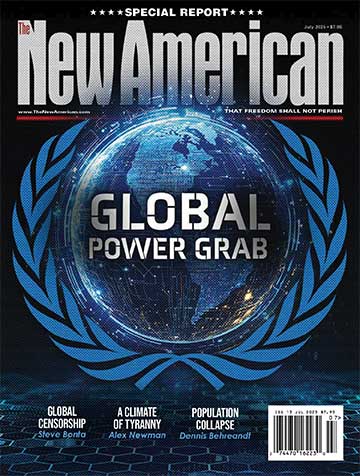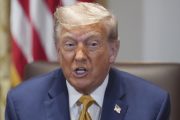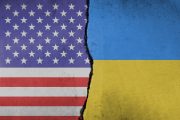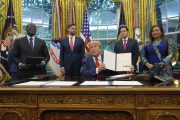“But, generally speaking, the Protective system in these days is conservative, while the Free Trade system works destructively. It breaks up old nationalities and carries antagonism of proletariat and bourgeoisies to the uttermost point. In a word, the Free Trade system hastens the Social Revolution. In this revolutionary sense alone, gentlemen, I am in favor of Free Trade.” — Karl Marx, addressing the Democratic Club, Brussels, Belgium; January 9, 1848
Most conservatives may be shocked to learn that Karl Marx, the father of communism and coauthor of the Communist Manifesto, favored the concept of “free trade,” because, as he put it, “It breaks up old nationalities” and “hastens the Social Revolution.” This is important because the ultimate goal for Marx and other communists has been to have a homogenous world without national boundaries or nation-states, a world devoid of any socio-economic classes or wealth inequality — a virtual “workers’ paradise,” or so communists say. However, before the state (or governments) can “wither away,” as Marx put it, to form that ever-elusive workers’ utopia, the state must first become empowered by a “dictatorship of the proletariat.” The aims of this new so-called people’s government would be to equalize all things and eliminate any perceived economic injustices through the takeover of the “means of production,” such as factories, farms, and land, away from private ownership in order to “redistribute of wealth.” This in a nutshell is Marxism 101 — the socialist road to communism that always results in tyranny.
Today’s architects for global union or one-world government seek to achieve their aims through an overlapping patchwork of multilateral integration schemes and supranational economic unions predicated under the guise of “free trade.” This is not to say that free trade in itself is inherently wrong or evil or that it always ultimately results in a communist world government. To the contrary, free trade, simply understood as one businessman negotiating with another or group of businessmen overseas, is good, especially if the two groups of businessmen are able to offer the other party with either raw or manufactured goods that are not available in his own country.
A businessman trading, as in exchanging or bartering, goods from his country for either money or the goods from another is mutually beneficial. However, the moment government steps in, you no longer have free trade. Instead you have regulated trade. In this regard trade agreements such as the Trans-Pacific Partnership (TPP), the Transatlantic Trade and Investment Partnership (T-TIP), the Free Trade Agreement Between the United States of America and the Republic of Korea (KORUS), and the North American Free Trade Agreement (NAFTA) all constitute regulated trade agreements. Each of these agreements brings in the involvement of more government oversight and regulation, as well as establishes new regional international governance in the form of “Joint Committees” or “Free Trade Commissions” where previously no such governance existed. The same is unfortunately true of NAFTA’s intended replacement, the United States-Mexico-Canada Agreement (USMCA), and likely also true for all subsequent new bilateral free trade agreements (FTAs) such as the US-Japan Free Trade Agreement that is currently being negotiated.
A recent study conducted by researchers from the University of Ottawa found that 57 percent of the text of the USMCA was copied from the TPP. According to the study, entitled “How much of the Transpacific Partnership is in the United States-Mexico-Canada Agreement?,” researchers found that the “USMCA closely tracks the structure and text of the TPP.” Further elaborating, “29 out of 30 TPP chapters have equivalents in the USMCA and 72 percent of the articles in the matched USMCA chapters are found in both agreements.”
Among one of the chapters in the USMCA that also bears a strong resemblance to one from the TPP, is the USMCA’s Chapter 30 on “Administrative and Institutional Provisions.” With the exception of a few minor tweaks, USMCA’s Chapter 30 reads almost word-for-word with the TPP’s Chapter 27, also entitled “Administrative and Institutional Provisions.” Both chapters establish the administrative or executive governing bodies for each of the agreements once they go into effect. Chapter 27 of the TPP establishes its governing “TPP Commission,” and likewise Chapter 30 of the USMCA establishes the USMCA’s governing “Free Trade Commission.” Both commissions are empowered with identical supranational powers, including the ability to consider proposals to amend their respective agreements without the consent of Congress; change the schedule for the elimination of certain duties or tariffs; have the power to dissolve, merge, or create new lower committees; control the flow or movement of foreign nationals; and to promote the economic integration of the participatory nation-states. This in effect makes both the TPP and USMCA “living agreements,” akin to the European Union.
And the USMCA may not be the only Trump trade initiative that bears resemblance to Obama’s TPP regulated trade scheme. During a press conference following a listening session at the Farm Progress Show in Decatur, Illinois, Secretary of Agriculture Sonny Perdue revealed that the Trump’s administration’s recently announced FTA with Japan might also be similar to the TPP. When asked how the proposed US-Japan agreement compares with the TPP, Perdue said, “I think it’s going to be equal if not better.”
With regard to selling U.S. pork to Japan, the new agreement will only give U.S. pork producers the same level of access to Japan’s market as what was already agreed to in the TPP. Nick Giordano, the vice president and counsel of global government affairs at the National Pork Producers Council, told CNN, “We’re getting what we had under the TPP and we’re not going to lag behind.”
Another key provision likely to be found in the new US-Japan FTA is an administrative or institutional provisions and dispute settlement chapter, in which the parties establish a joint committee composed of unelected bureaucrats and possibly co-chaired by the United States Trade Representative (USTR) and a cabinet-level Japanese ministry. In fact such a chapter exists in the KORUS FTA, which was initially negotiated between the Obama administration and the South Korean government in 2011, and recently renegotiated at the request of the South Korean government with the Trump administration in 2018. KORUS has the stamp of approval of both the Obama and Trump administrations. Article 22.2 of KORUS’s Chapter 22 on “Institutional Provisions and Dispute Settlements,” establishes a governing “Joint Committee,” possessing similar powers and functions as the USMCA’s “Free Trade Commission” and the TPP’s “TPP Commission.”
In 2018, South Korea also expressed interest in joining the TPP, renamed the Comprehensive and Progressive Agreement for Trans-Pacific Partnership (CPTPP), which the national legislatures of Mexico, Canada, and Japan have already ratified. Other CPTPP member-nations include Australia, Chile, Peru, and Singapore, all four of which have bilateral FTAs with the United States.
Likewise, Article 21.1 in Chapter 21 of the US-Australia FTA establishes an administrative “Joint Committee to supervise the implementation” of the agreement; Article 21.1 in Chapter 21 of the United States-Chile FTA establishes a “Free Trade Commission;” Article 20.1 in Chapter 20 of the United States-Peru Trade Promotion Agreement establishes a “Free Trade Commission;” and Article 20.1 of Chapter 20 of the US-Singapore FTA also establishes an administrative “Joint Committee to supervise the implementation” of the agreement. In the case of all four of these supranational Free Trade Commissions or Joint Committees, they are comprised of unelected government bureaucrats and/or the country’s trade or economic ministers; they can make changes to the agreement like delaying the elimination or lowering of tariff schedules; and they can dissolve, merge, or create new ad hoc committees tasked with integrating the economies of the parties.
In addition to establishing supranational administrative bodies, all of these bilateral FTAs (Australia, Chile, Peru, Singapore, and South Korea) are made under the terms and authority of the “Marrakesh Agreement Establishing the World Trade Organization” and they recognize each country’s ability or choice to settle disputes at the WTO. Each of these FTAs also explicitly states that they “reaffirm their obligations as members of the International Labor Organization (ILO) and their commitments under the ILO Declaration on Fundamental Principles and Rights at Work.” In these regards, so-called bilateral FTAs are no different than their multilateral cousins, which also contain the same disastrous sovereignty-destroying provisions.
In fact, one of the first tweets about the USMCA posted by Richard N. Haass, the president of the one-world government-building Council on Foreign Relations (CFR), was his hope that the USMCA would become the basis for reentering the TPP. “The USMCA looks to be the trade pact formerly known as NAFTA plus 10-20%,” Haass posted on Twitter, on October 1, 2018. “Hope it becomes a precedent for TPP. I suggest the US-Pacific Trade Agreement (USPTA).” The next day, Haass again took to Twitter, where he reiterated his renewed hope for the U.S. rejoining TPP, tweeting:
USMCA is NAFTA plus TPP plus a few tweaks. Whatever…if @realDonaldTrump and the Congress are now prepared to embrace a pro-trade agenda, it is all to the good. Ideally, US participation in TPP by another name would be next; failing that, a US-Japan FTA would be second best.
Although President Trump has made it clear that the he has no intention of reconsidering reentry in the TPP/CPTPP, it appears that Haass will be getting his “second best” wish in the form of the US-Japan FTA, which the US Trade Representative Robert Lighthizer is currently negotiating with Japan’s Minister of Foreign Affairs Toshimitsu Motegi. However, if anything can be learned from recent history it’s that a US-Japan FTA will likely be no different and no better than past FTAs. Instead, a US-Japan FTA, and likely any other bilateral FTAs currently down the pipeline for consideration by Lighthizer, will serve as yet another piece in the globalist patchwork for regional integration and ultimately world government under the guise of “free trade.” Watch out for globalist “bilateral” FTAs.
Photo: imaginima / E+ / Getty Images Plus
Related articles:
New “Bilateral” Trade Agreements Are Still Under Globalist WTO Authority
Creating a New World Order Out of Regional Orders
One Man’s Fight Against the Global Trade Order
Stop the Deep State’s “Free Trade” Agenda for Global Government






